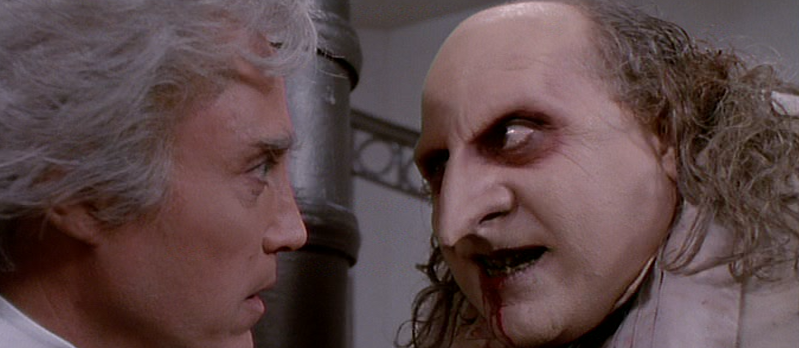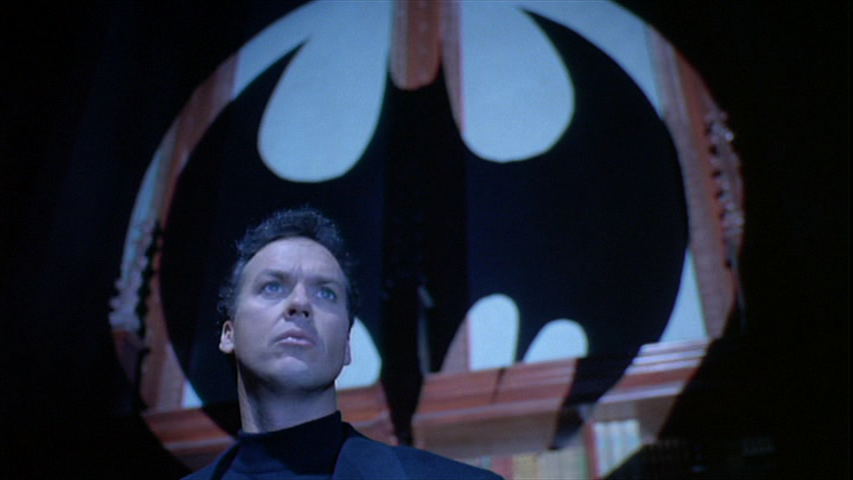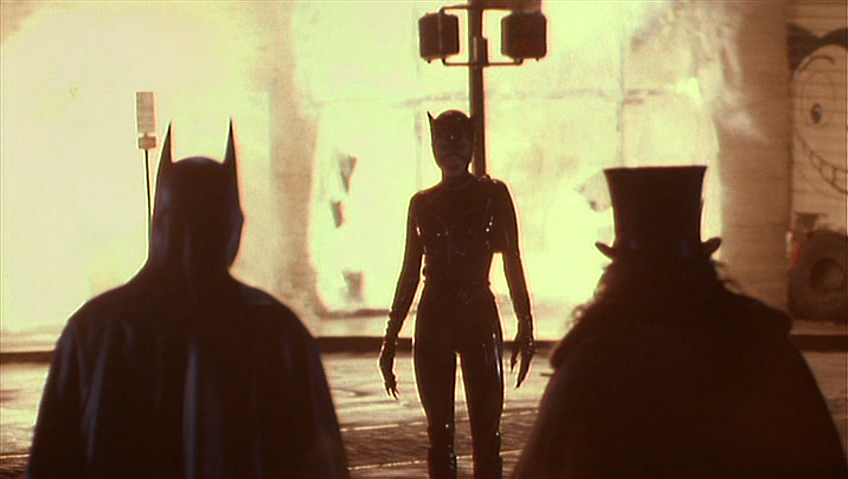

“You gotta admit I played this stinkin’ city like a harp from hell.”
For a film containing the hero’s name in the title, Batman Returns features very little of either Batman or the uncostumed Bruce Wayne. Instead, director Tim Burton chooses to introduce two villains—Catwoman and Penguin—who dominate their scenes and give us a much darker, weirder, and more sexualized outing than the film’s predecessor. In many ways, Batman Returns is the risqué curiosity that audiences thought the original was. Like Batman, Returns is stylistically outstanding, featuring great costume and set design. But narratively the film is scatterbrained; character motivations are sloppy or non-existent and a franchise that was known for campiness reverts back to it in several ways. Luckily, Burton is always good with style and spectacle, and he’s working with three beloved and iconic characters, so even though there are many things done wrong here, the general weirdness of Burton having fun in Gotham City is delightful.
After the commercial success of Batman, Warner Bros. was anxious to have Burton return to direct a sequel, but the director wasn’t really interested, calling the idea of a sequel “a most-dumbfounded idea.” In the interim, he directed the bizarro Edward Scissorhands, but he was swayed to return for the sequel when a rewrite of the script by Daniel Waters was approved by the studio. Burton had been impressed with the writer’s work on the black comedy Heathers, and thought his tone would fit the world Burton had created. The script went through a lot of changes. At times, it included the incident that turned Harvey Dent into Two-Face and Robin becoming Batman’s side-kick. Instead, Catwoman’s taser-enhanced kiss goes to a one-off villain (Dent isn’t even in the film), and Robin wasn’t introduced until Batman Forever. What Burton eventually settled on was a script that halfheartedly digs at the driving force behind the masked vigilante, but clearly favors its villains over Michael Keaton’s understated Batman.

The mis-matched collection of scenes that are cobbled together into a lumpy story relegate the caped crusader to the shadows, showcasing instead the bizarre and wonderfully realized antagonists. After an opening scene that gives us a glimpse of Oswald Cobblepot’s demented childhood—he is born with flippers for hands and eats the family cat—he is thrown into the river by his parents, baby carriage and all. He then floats to an abandoned zoo where he is raised by penguins, emerging thirty-some years later as the round and pasty abomination known as Penguin (Danny DeVito), kidnapping corrupt tycoon Max Shreck (Christopher Walken) and blackmailing him. There is a half-baked plotline of Shreck and Penguin becoming brief allies so Penguin can run for mayor, but DeVito’s character is mostly utilized as a conduit for Burton’s macabre tendencies that are better showcased in the Keaton-starring Beetlejuice (1988). Shreck is a caricature (some say of current U.S. President Donald Trump) as he jumps between personas of cheerful altruism and criminal ruthlessness.
Selina Kyle (Michelle Pfeiffer) is the spectacled hot mess of an assistant to Shreck who talks to herself and constantly sees men come and go in her life. While unintentionally perusing the wrong filing cabinet, Selina discovers that Shreck’s plans for a power plant is actually a front for an energy-syphoning operation. Shreck pushes her from a highrise window to silence her, but she is resurrected by a freaky legion of cats and returns as a leather-clad, clawed, whip-toting, acrobatic, hyper-sexualized villain/love interest to Bruce Wayne.

What the film seems to be trying to do is have Bruce Wayne come to terms with his similarity to the villains. Both Catwoman and Penguin (and to a lesser extent, even Max Shreck qualifies) are psychologically messed up, but their perversions are matched by those of our hero. Like Selina Kyle, Bruce Wayne has incredible power but no true responsibility to use it for any particular purpose; they are both promiscuous loners that are driven by a half-buried wish for revenge. When Penguin begins his rise to public adoration, Bruce finds himself struggling to determine what ground he stands on that allows him to claim the moral high ground.
Just like Jack Nicholson’s Joker, the casting of both villains here is nearly perfect, with DeVito and Pfeiffer appearing comfortably at-home in two completely over-the-top and goofy roles. Screenwriter Daniel Waters admits that as he got further into the writing process he began writing the role of Penguin specifically for DeVito, even though he was not officially cast at the time. His performance is delightfully repulsive, as black liquid froths from his stained mouth, his lobster-like hands fiddle with anything they come near, and he lets rip with every perverted comment that comes to mind (many of them barely qualifying as innuendo). He is snarling and homicidal as the leader of the killer circus troupe that wreaks havoc on Gotham.

The role of Catwoman was originally supposed to go to Annette Bening, but she had to drop out when she became pregnant. The line of actresses vying for the chance to replace her was long—Sean Young (of Blade Runner fame, who was initially slated to portray Vicki Vale in Batman1), Kim Basinger (who did portray Vicki Vale in Batman2), Lena Olin, Cher, Jennifer Jason Leigh, Ellen Barkin, Susan Sarandon, plus several others… and Michelle Pfeiffer. Pfeiffer, of course, won the role, which is hilarious to me because only a few years prior Keaton had vetoed her casting as Vicki Vale. The two had previously dated and he didn’t want her to be his love interest in the film. In an ironic twist, Burton really felt that she was right for the role of Catwoman and cast her, giving her the opportunity to literally lick Keaton’s face.
The unholy mélange of hyper-sexualization and body horror sets Batman Returns apart from the original. Its ambitious but sickly sweet characters fit perfectly in Burton’s wacky world where villains travel via rubber duck or propeller umbrella, skull-helmeted clowns ride motorcycles, kidnap babies, and mow down crowds with Gatling guns, and penguins with missiles strapped to their backs attempt to take over the city. It was a pretty big ask to expect this to have mass appeal. I’m glad Warner Bros. let Burton do his thing, though, as a wild misfire is almost always better and more memorable than a handcuffed, cookie-cutter effort.

After spearheading the serious superhero genre with Batman,3 the series falters here, simultaneously reverting to the contrived silliness of previous comic book adaptations and embracing Tim Burton’s most offbeat tendencies. The result, while visually striking and generally very fun, hampered the rise of the superhero film for several years. Neither Burton nor Keaton would return for Batman Forever,4 and the series would retreat to the safety of its camp roots for two more films before Christopher Nolan instilled the franchise with his own take on gritty “realism” that allowed it to dominate the 2000s. Though Burton’s second and last outing directing Batman is uneven and somewhat unwholesome, it is the work of a visionary artist that was allowed to make the film he wanted to—as weird as that turned out to be—and have it played in front of hundreds of thousands of people. I’m always on board for that.
1. There’s a great video of her going on Joan Rivers’s talk show in a home-made costume to “audition” for the role of Catwoman. Her performance makes me think she would have made a better Harley Quinn than Catwoman, though.
2. I hope I don’t need to point out how silly it would have been to have Basinger portray Catwoman; unless they were going to have Vicki Vale become Catwoman and nix Selina Kyle entirely.
3. Batman is still playful, unlike many of the stone-faced adaptations that underwhelmed as the 2010s wore on. It achieved a balance of grit and silliness required to properly bring comic book heroes to the screen, focusing on more mature themes while acknowledging some of the inherent campiness of superheroes. But at the time, it was the darkest live-action comic book adaptation by far.
4. Burton almost directed a Superman film that would have starred Nic Cage, but it never came to fruition. Keaton would eventually return to the superhero genre to great acclaim as the title character in Birdman, and as Vulture in the Marvel Cinematic Universe, beginning with Spiderman: Homecoming (2017).
Sources:
Jones, Alan. “Batman in Production”. Cinefantastique. November 1989.
Burton, Tim, Daniel Waters. Shadows of the Bat: The Cinematic Saga of the Dark Knight. Warner Home Video. 2005.
Broeske, Pat, Anne Thompson. “Clawing for Catwoman”. Entertainment Weekly. 9 August 1991.
Burton, Byron. “The Battle to Make Tim Burton’s ‘Batman’”. Hollywood Reporter. 21 June 2019.